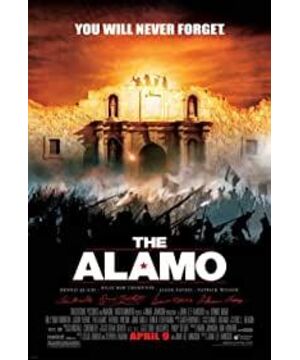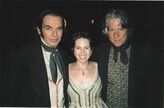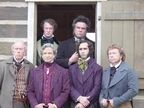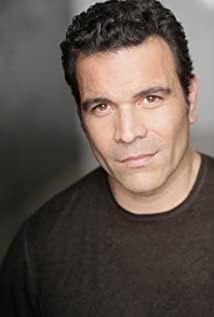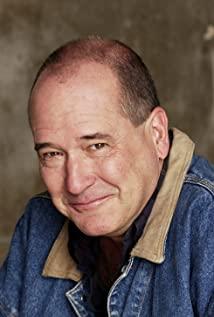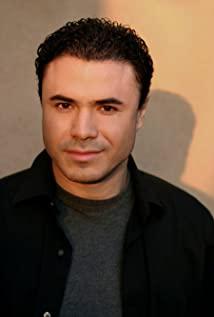A second later, several people tried to explain to me in a succinct way what the "Alamo" was all about. A colleague asked me to go home and ask the kids because they had to learn in history class. A colleague was wearing Google glasses that he just got, and quickly searched for relevant photos. In these few words, I finally understood the source of my astonishment. Not knowing the Alamo in Texas is like not knowing Pingxingguan in Shanxi.
To make sure I was completely literate, a colleague gave me a book about the Alamo for Christmas. Later, it was estimated that this was inappropriate. After all, there are not many people reading books these days. It is difficult to guarantee that this guy will be put on the shelf when he takes it back. He also recommended me to watch the movie The Alamo, which was filmed in 2004. Let me introduce it so that everyone can meet Americans in the future, and when it comes to Texas, there is more common sense. I do this because of my ignorance, to gain everyone's knowledge. you are welcome.
The Alamo in the 1830s, and all of Texas, was pretty wild. Texas was part of Mexico at the time. In those pioneering days, the land was not as precious as it is today. In the early 19th century, in order to attract people to move to Texas, the Mexican government promised each individual or family 4,428 acres of land, an area equal to about 18 square kilometers, equal to the size of a small town today. , In addition, new arrivals enjoy a ten-year tax exemption. Interestingly, in the 19th century, it was a very legitimate and glorious thing to rush to Texas from other places to become Mexican nationals.
"Remember the Alamo" - Southbridge - Southbridge's Blog
But there is a struggle between the "federalists" and the "centralists" in Mexico, the former allowing more autonomy for the subordinate regions and the latter emphasizing centralization. After President Antonio López de Santa Anna, who belonged to the central faction, came to power, he repealed the 1824 constitution and began to run toward dictatorship. He also began to impose more restrictions on northern Texas, such as the introduction of taxes. Texans accustomed to not paying taxes didn't buy much of these new deals. Santa Anna was very upset and felt that the Texans who were embraced by the Mexican government were ungrateful. And Texans are also upset, feeling that the freedoms of the past (including the freedom to own slaves) are being eroded by the Mexican government. At first, Texans' attitudes were divided. Stephen Austin, one of the pioneers of Texas independence, was a moderate, but the Mexican government indiscriminately savagely imprisoned him, so that moderates like him gave up their illusions and became a die-hard independent. The independents began to engage in sporadic fighting with Mexico, and eventually Santa Ana decided to go on a personal crusade to solve these "pirate" mutinies once and for all. This is the background of the Battle of the Alamo. The Alamo was originally an unfinished church built by the Spaniards, with very thick walls. After a little fortification, it became a fortification.
The Battle of the Alamo took place on February 23, 1836, and was arguably the most decisive defeat in American history. One side of the battle was the "Western Napoleon" Santa Anna, who was "going on a personal expedition", and brought with him a regular Mexican army with strong morale. On the other side were the more than 100 Texans besieged, including "regulars" and militias, and there were conflicts between regulars and militias. Many Texans who went to war were land speculators, including artisans, farmers, doctors, lawyers, and so on. Among them is the legendary swordsman James Bowie. There was also Davy Crockett, known as the "King of the Western Frontier." He was originally a Senator from Tennessee. After losing the election in 1835, he said to voters in his defeat speech: "Since you don't vote for me, then you all go to hell. I'll go to Texas."
Characters like Crockert are intriguing. This kind of person is not the type to live on his own. This is also a personality type. Cimmaron of Oklahoma is also such a character: to a new place, to build a small town, but unable to "settle", he would rather die to find a new frontier. These people are willing to revolutionize and good at entrepreneurship. They have no patience for construction and management. To keep them successful is to kill them. Even after entering a system, they are more comfortable with the posture of the opposite. That was the case with Crockett, who, even as a congressman, preferred to contradict President Andrew Jackson.
This gang of legends and rabble is in the city, hoping for some rescue. William Travis, the general who defended the city, wrote letters to ask for help, but only 36 people came from the nearby town of Gonzalez, bringing the defending soldiers to nearly 200. Santa Anna stood still outside the city, occasionally firing a few shots at night, preventing the other party from getting a good night's sleep. Santa Anna regards the lives of his soldiers as chickens. Waiting like this is not to sympathize with the lives of his soldiers, and let the opponent easily win when they run out of ammunition and food. He wants to be like a cat, playing enough with mice before he eats them. He hopes to break the opponent's will, so that the opponent can't die. He even opened a passage, trying to lure the "rebel chief" Sam Houston over to him, so that other independence seekers would know what would happen to anyone who undermined Mexico's territorial integrity. Houston, on the other hand, has some strategic vision, not caring about one city and one pool, but focusing on the independence of the entire Texas, so when he didn't come, Santa Anna had to attack and quickly won the Alamo. There are corpses all over the city inside and outside the Alamo, and the state is appalling. This is not a military tale of winning more with less, but a fiasco of being outnumbered. When I ask kids who have studied Texas history about the battle, the word they think of is "slaughter."
But the independence of Texas also has many accidental factors. It was a strategic mistake that the Mexican army went to the north to conquer without any response. The Chinese name of the movie The Alamo is "Border Town Heroes". This translation is very inappropriate. The Alamo is not a "border town", but is in the hinterland of Texas. If it happens to be on the border of Mexico, the Mexican army will be convenient for communication and history, and history should be rewritten. Texas is really big, slightly larger than France, nearly twice the size of Germany, and nearly three times the size of the United Kingdom. Expeditions beyond the reach of distant places, whether it is Zhuge Liang's northern expedition or Napoleon's Russian expedition, are extremely risky. Quick wins can be done, but everyone can't afford to delay, especially in January and February when the weather is bad. As soon as it goes on, the situation will be reversed if the weather is bad, the geographical position is not good, and the people and no one are in harmony. Well, I don't play anymore, after all, I'm not a famous player from Baekdu Mountain.
After taking the Alamo with ease, Santa Ana went on an expedition to try and bring Houston's army to a complete end. But Houston retreated all the way, lured the enemy deep, and when the time was right, shouted the slogan "Remember the Alamo" and defeated Santa Anna's army. The slaughter of the Alamo aroused the anger of the Texans, and Houston, who was standing still, felt guilty for not providing support. At this time, the soldiers were underdogs and would be mourners. With this huge energy of humiliation and anger, Texas went from a fiasco to a rout. The battle of San Jacinto took only 18 minutes, and Santa Anna, the "Napoleon of the West", met his Waterloo here. The defeat was not counted, and the man was captured alive. In order to survive, Santa Ana allowed Texas to become independent from Mexico and become an independent country. If it wasn't for Santa Anna who was determined to personally crusade and was captured alive, Houston took a big advantage. The result is still unknown. Maybe Texas is still Mexico today. At that time, there were a lot of independent places in Mexico, but only Texas succeeded.
"Remember the Alamo" - Southbridge - Southbridge's Blog
But then again, 75% of Texans were from the North America at that time, and the U.S. government also supported the independence of Texas. If it weren't for Mexico's ceding of land, Texas might have been taken by the United States. Although Santa Ana is a dictator, he still has some foresight. He wants to end the trend of division of the country through encirclement and suppression, so that the future children and grandchildren of Mexico can only receive the food of the Americans. Today, from Houston to Dallas, it is common to see Mexican immigrants standing on the streets, waiting for Americans to take them back, doing cheap jobs, renovating, mowing, and repairing roofs, which is not what Santa Ana worries about !
The revenge slogan "Remember the Alamo" has very different meanings in the United States and Mexico. In the Alamo, nearly half the Mexicans and Americans visit. I don't know how Mexican visitors feel? Some Mexicans may be the more than 12 million illegal immigrants who sneak into the United States. I have never quite understood why the United States is soft on this group, but it is sceptical about Chinese immigrants who have immigrated through work and other means. It is estimated that there are historical reasons for this, because Texas is bigger than Texas, and it was originally Mexico in the early years. of.
The Battle of the Alamo was seen as a symbol of Texans fighting for independence and freedom, a portrayal of "freedom or death," and a core American ethos. Ten years after Texas became independent, it joined the United States. To this day, Texans view the U.S. federal government with an “Alamo” spirit.
But this "American spirit" sometimes begins to conflict with American interests. After Obama took office, he tried to control Americans in many ways from the aspects of medical insurance and gun control. Many Texans have threatened that if the federal government restricts Texas' freedom too much, Texans can secede from the United States in the same way that they seceded from Mexico. Since we were able to secede from Mexico back then, why can't we secede from the US today? It's just that the comparison of military power today is not comparable to 1836. Today, in the United States, drones are used in wars, and the boots of soldiers can never set foot on enemy territory once. If Texas became independent again, Obama would not have to "drive his own expedition" to the South. But Texas' maverick stance continued. Driving along the way, I saw signs on the highway that said: Don't mess with Texas. If you violate the rules, you will be fined as much as you can (Don't mess with Texas. You will be fined ...if...) . Texas is also said to be one of the most hated states in America because of this self-righteous attitude. Texas believes in individual freedom and the role of the market, and dislikes too much government intervention. It is a place where the spirit of Republican governance is relatively pure. Texas is also the fastest growing and most immigrant state in the United States. In 2013, Time magazine had a cover article, saying that the future of America may be the style of Texas today. After more than ten years, we finally reached the hinterland of the United States.
View more about The Alamo reviews


